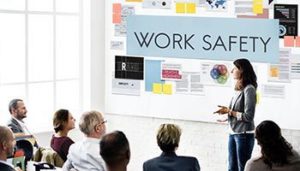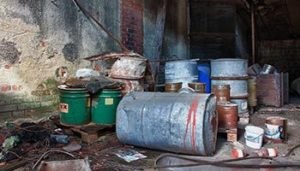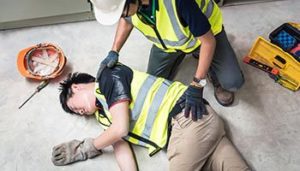An OSHA best practices guide can indicate recommended practices for safety and health programs so that your business does not experience any costly violations.
OSHA is the Occupational Safety and Health Administration, an agency within the US Department of Labor. The creation of OSHA was mandated by the Occupational Safety and Health Act of 1970 (also called the OSH Act), which provides workers protection from on-the-job hazards.
The OSHA law applies to all businesses unless they are excluded. Examples of excluded businesses are governmental bodies, churches, and the self-employed. Throughout the nation, the majority of private companies are legally required to be OSHA-compliant.
This OSHA best practices guide is intended to help you focus on ways that you can strengthen your approach and avoid violations.
Table of Contents
9 OSHA Best Practices
Here are a few key best practices to maintain OSHA compliance straightforwardly and seamlessly:
1. Post basic OSHA information for employees to see.
The OSH Act guarantees US workers that they will be informed of their rights and responsibilities in the workplace. This part of OSHA compliance is accomplished by simply posting OSHA 3165, OSHA’s free workplace poster. It should be displayed somewhere that it is visible to both current and potential employees.
2. Train managers, supervisors, and employees.
Any OSHA best practices guide would be incomplete without a discussion of training. Make sure that everyone in the workplace is performing their jobs correctly if you want to avoid accidents. Those who work for your company should know about hazards and how to control them. They should clearly understand the tools and materials involved in their jobs.

- Be certain that your management leadership knows how they are responsible for health and safety. These professionals also need to know how to ensure the accountability of the team who reports to them.
- Provide training for supervisors so that they know all the employee hazards. They should provide fast refreshers to remind personnel of key training principles, and they should take disciplinary action as needed.
- Confirm that your employee training has covered all possible hazards on your worksite. Check that you have advised everyone in your workforce of protections, and make sure that your staff has a thorough comprehension of critical training information.
- Employees who are taking on new jobs or who are entirely new to the organization are the likeliest to suffer injuries or illnesses since they are unfamiliar with their environments. Guide them carefully.
- Get training recommendations from your OSHA consultant (which might be us). You can also ask them about performing the training themselves.
- Implement microlearning techniques that involve breaking down complex safety topics into smaller, manageable segments. This makes it easier for employees to absorb and retain critical safety information.
3. Be prepared for inspection.

4. Self-inspect.
Central to OSHA’s best practices is proactivity – knowing your own environment so that you can make improvements. To verify the locations of any hazards and if your controls are working, you need to self-inspect regularly.

5. Evaluate the workplace.

- You can improve your safety and health program by looking for patterns. Regularly review a few months of records to see if you can identify any. To optimize your approach upfront and make helpful improvements, look back through illness and injury records over the last few years to uncover trends.
- Understand how to investigate when you have an incident.
- Try to reveal hazards in processes and tools through regular job reviews, going through each task.
- Be certain that anyone who works for you knows that they should let someone in management know whenever they see anything problematic and potentially dangerous.
- Stay current on the newest hazards in your industry. Whenever you make any equipment or process changes, get a professional compliance assessment so you do not create additional hazards.
- If there are any hazards in your workplace, you want to know so you can mitigate and resolve them. Either bring in a private consultant or get a consultation directly through OSHA.
- Enhance your workplace evaluation process by incorporating a digital incident reporting system.
6. Communicate about any hazardous chemicals.

When any company is aware that its workers may be exposed to dangerous chemicals, they need to provide information related to the substance and offer guidance on how to guard against it. Employees have a right to know about any hazards they might encounter, including chemicals; they also have a right to know methods they can use to stay safe. Providing that information allows companies to maintain compliance.
7. Prevent and control hazards.

The following are best practices for hazard prevention and control at your workplace:
- Create non-routine activity and emergency plans that have safeguards to keep your employees safe.
- Determine what controls you need and how to introduce them through a review of a hazard control plan.
- Utilize a hierarchy of controls for seamless identification and analysis of hazard controls.
- Assess current controls. Research possible cost, reliability, and safety benefits of next-gen technologies so you can decide if you want to make a change.
- Engage your employees in your hazard control process since they will often have ideas about controls and the conditions underlying hazards.
- Use environmental design principles to minimize workplace hazards, arranging spaces and equipment to enhance safety and reduce risks.
Specifically, take the following six steps to ensure you are preventing and controlling hazards in your workplace – i.e., that you are following OSHA best practices for compliance:
- Determine what your options are for controls.
- Choose your controls.
- Create a hazard control plan and maintain it.
- For emergency and irregular scenarios, you should have special controls for safeguarding employees in those unexpected situations.
- Establish your chosen controls on the job site.
- Check back after time to verify that your controls are working through periodic self-inspections, using regular preventive maintenance to help maintain your controls’ effectiveness.
8. Report and keep records of illnesses and injuries.
Whenever an employer finds out about work-related incidents that result in three or more workers’ in-patient hospitalizations, they need to let OSHA know within 8 hours. The same is true if any deaths result from work-related situations. In fact, any heart attacks that occur at work and are fatal must be reported.
To reach OSHA and report these incidents, you can call them at 800-321-OSHA (6742). You can also typically report in person; through www.osha.gov, you can find the closest local OSHA office.
You do not need to report deaths from accidents that occur either in commercial vehicles or in private cars on public roads unless the location is a construction zone.
OSHA best practices for record-keeping require you to know if you need to fill out Form 300, Log of Work-Related Injuries and Illnesses. This official federal document keeps records of these grave incidents. While the majority of service, real estate, insurance, finance, and retail trade businesses are exempt from this requirement, most of the remainder of companies that have at least 11 employees must complete the form.
9. Get buy-in from employees and leadership.

- Post a worker safety and health policy next to the poster (see #1 above). OSHA provides model policy statements. Here is one from the state of Pennsylvania. It is brief.
- Conduct an all-employee meeting to discuss health and safety. State your organization’s goals on the subject.
- If you are in management or ownership, get personally involved with inspections to clearly demonstrate your concern.
- Follow the appropriate safety protocol in areas of your workplace, regardless of how long you are in the area.
- Make employees responsible. Designate health and safety responsibilities just as you do production responsibilities.
- Provide a sufficient budget and authority for individuals to carry out their assignments.
- Confirm that all responsibilities are completed.
- Create an accountability system to ensure all health and safety rules are followed.
- Review your program annually and consider adjustments.
- Get your employees interested in and invested in safety by having them help investigate accidents, perform training, and conduct inspections.
10. Implement a ‘Lead by Example’ Initiative
A practical and impactful addition to OSHA best practices is the implementation of a ‘Lead by Example’ safety culture initiative. This approach emphasizes the importance of leadership in setting the standard for safety practices within the organization.
Key elements of this initiative include:
- Senior management and team leaders actively participating in all safety training alongside employees.
- Leaders consistently adhering to safety protocols in all situations, demonstrating their commitment to these standards.
- Regularly scheduled safety discussions led by managers, where they share personal experiences and lessons learned regarding workplace safety.
- Establishment of a mentorship system where experienced workers guide new employees in safety practices, fostering a culture of mutual responsibility and learning.
- Recognition and rewards for leaders who excel in promoting and adhering to safety protocols, encouraging a top-down approach to workplace safety.
By having leaders actively engage in and advocate for safety measures, this initiative aims to create a work environment where safety is a shared value and priority at all levels of the organization.
Highly Rated Compliance Training And Education
Hopefully, this OSHA best practices guide has reminded you of important OSHA strategies and compliance considerations. At AOTC, our compliance training and educational programs identify risk factors while often improving employee productivity and morale. Want to learn more? Contact us online or give us a call .


